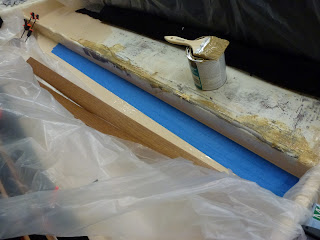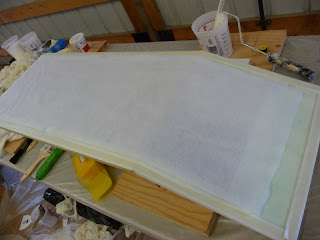On the SeaRey support forum John Dunlop showed how to build a fiberglass instrument panel. He made it look so easy, but like anything done by an experienced builder it wasn't.
First, build the form from a 24"x48" prefab piece of shelving material and some 2x4s
Next, a layup using West Systems and 1/8" Last-a-Foam.
Despite weighing it down, after 2 tries I was still getting air bubbles on the face of the panel, which was unacceptable. On both tries when I tried to sand the bubbles out I ended up going through the glass and into the foam. Sooo..... I got stubborn, and decided to learn how to make vacuum bag fiberglass layups. Funny though, when I tried to destroy to failed pieces they were a real b**ch to break in half for the garbage, 1/8" foam layup is a lot stronger than it appears.
I showed up bright and fresh Monday morning at
Fiberglass Supply in Burlington, WA. and despite the ungodly hour of 0800, they were kind enough to take the time to show me how to set up a simple system. Reference came from
a tutorial by West Systems, and the book
Advanced Composite Techniques
.
One good idea I finally had: instead of getting down on the floor and trying to measure the cloth, or wresting the fabric as it shifted around on the table, I covered my workbench with a 2 mil dropcloth and drew the measurements directly on it with a Sharpie. Much easier.
Setting up the hardware was "interesting". From L-R is the hose to a vacuum pump (more on that later), a 7"x2" piece of PVC pipe with the left endcap tapped for the hose fitting, and the right side tapped for 1/4" brass barb. (The PVC pipe acts to smoothen pressure pulses from the pump.) Next comes a 1/4" rubber hose with a brass t-fitting tapped to a vacuum gauge from an auto parts store, 1/4" shutoff valve, more hose and a 1/4" brass barb tapped into a pickle jar. The jar is for collecting excess epoxy, but only a few drops came through on my pull, so I was a bit too stingy with the epoxy. The white hose goes to the suction cup attached to the layup
Prep the mold by painting it with a "release agent", a barrier that keeps the resin from sticking. You're supposed to spray it, but I had good success with painting it on.
And cut all your material.
During the layup I found the glass became translucent and nearly disappeared, so on the top layer I marked the ends.
Rehearsal: 2 layers of glass, foam, 2 more layers of glass, release film, perforated film for the epoxy to be sucked through, breather material for spacing (white cottony stuff), and final sealing layer.
The whole stack was laid over a chair in order of use.
Let the games begin. First 2 layers of glass, followed by the foam core. In retrospect I was a bit too aggressive about squeezing resin out of the bottom layers of glass that are the face of the panel, I should have left them a little damp and let the vacuum pull the excess out through the holes in the foam core, as you see here. I also cheated and gently put a couple 1/4" staples at the top corners of the foam (in areas that will be trimmed off) to hold it in place on the mold.
Now let's start laying up the bag. For some parts you actually do use a bag, but the term seems to also be used for table or mold layups. Note the "mastic", or double sided tape on the perimeter of the mold. Everything has to fit inside it.
The final layer (or bag) is cut oversized to keep it from pulling, and the vacuum causes folds/creases that must be sealed with more mastic.
A small hole is cut in the center, the suction cup is attached, pump started, and valve slowly cracked to introduce vacuum. Then you move around with a roll of mastic, sealing the folds/creases and pressing the seams tight.
You get what you pay for in tools. A decent vacuum pump will run you $300+, and while Fiberglass Supply sells a converter to make your shop air compressor into a vacuum pump, they were out of stock. Instead I purchased a middle of the road unit from my local Harbor Freight. While it pulled a decent vacuum, it sprayed so much oil it looked like a vaporizer. I tried a couple cotton dust filter masks but they quickly became saturated. I ran back and bought another pump, same thing. I wasn't about to abandon the layup so I just kept it going, kept an eye on the oil level, and got a book out for a few hours.
Pulled a decent vacuum though, 20" at one point. It was interesting how even a small relocation of the suction cup could give me another inch or more of vacuum.
The morning after. Time to see how it went.
Not bad....
Not bad at all. Some minor gaps in the slurry, but pressing on what appear to be air bubbles show them to be firm, with zero give like a bubble. Next time I would not be so aggressive about squeegeeing out the resin and leave it a little damp. I had mechanics Scott, JR and Hal look it over and they all agreed it did not need to be redone.
The panel has now been turned over to my friend Gordon at
Second Story Construction for a laminate. Nothing like a good piece of hickory.































































